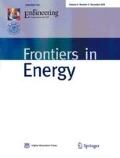Abstract
The higher heating value of five types of nonwoody biomass and their torrefaction char was predicted and compared with the experimental data obtained in this paper. The correlation proposed in this paper and the ones suggested by previous researches were used for prediction. For prediction using proximate analysis data, the mass fraction of fixed carbon and volatile matter had a strong effect on the higher heating value prediction of torrefaction char of non-woody biomass. The high ash fraction found in torrefied char resulted in a decrease in prediction accuracy. However, the prediction could be improved by taking into account the effect of ash fraction. The correlation developed in this paper gave a better prediction than the ones suggested by previous researches, and had an absolute average error (AAE) of 2.74% and an absolute bias error (ABE) of 0.52%. For prediction using elemental analysis data, the mass fraction of carbon, hydrogen, and oxygen had a strong effect on the higher heating value, while no relationship between the higher heating value and mass fractions of nitrogen and sulfur was discovered. The best correlation gave an AAE of 2.28% and an ABE of 1.36%.
Similar content being viewed by others
References
Sheng C, Azevedo J L T. Estimating the higher heating value of biomass fuels from basic analysis data. Biomass and Bioenergy, 2005, 28(5): 499–507
Friedl A, Padouvas E, Rotter H, Varmuza K. Prediction of heating values of biomass fuel from elemental composition. Analytica Chimica Acta, 2005, 544(1–2): 191–198
Shen J, Zhu S, Liu X, Zhang H, Tan J. The prediction of elemental composition of biomass based on proximate analysis. Energy Conversion and Management, 2010, 51(5): 983–987
Nhuchhen D R, Abdul Salam P. Estimation of higher heating value of biomass from proximate analysis: a new approach. Fuel, 2012, 99: 55–63
Akkaya A V. Proximate analysis based multiple regression models for higher heating value estimation of low rank coals. Fuel Processing Technology, 2009, 90(2): 165–170
Cordero T, Marquez F, Rodriguez-Mirasol J, Rodriguez J J. Predicting heating values of lignocellulosics and carbonaceous materials from proximate analysis. Fuel, 2001, 80(11): 1567–1571
Erol M, Haykiri-Acma H, Küçü kbayrak S. Calorific value estimation of biomass from their proximate analyses data. Renewable Energy, 2010, 35(1): 170–173
Jenkins B M, Ebeling J M. Correlation of physical and chemical properties of terrestrial biomass with conversion. In: Proceedings of Energy from Biomass and Wastes IX, Chicago, 1985, 371–400
Kathiravale S, Muhd Yunus M N, Sopian K, Samsuddin A H, Rahman R A. Modeling the heating value of Municipal SolidWaste. Fuel, 2003, 82(9): 1119–1125
Callejón-Ferre A J, Velázquez-Marti B, López-Martínez J A, Manzano-Agugliaro F. Greenhouse crop residues: energy potential and models for the prediction of their higher heating value. Renewable & Sustainable Energy Reviews, 2011, 15(2): 948–955
Graboski M, Bain R. Properties of biomass relevant to gasification [Fuel gas production]. Biomass gasification—principles and technology, 1981, 41–69
Thipkhunthod P, Meeyoo V, Rangsunvigit P, Kitiyanan B, Siemanond K, Rirksomboon T. Predicting the heating value of sewage sludges in Thailand from proximate and ultimate analyses. Fuel, 2005, 84(7–8): 849–857
Jiménez L, González F. Study of the physical and chemical properties of lignocellulosic residues with a view to the production of fuels. Fuel, 1991, 70(8): 947–950
Parikh J, Channiwala S A, Ghosal G K. A correlation for calculating elemental composition from proximate analysis of biomass materials. Fuel, 2007, 86(12–13): 1710–1719
Demirbas A. Calculation of higher heating values of biomass fuels. Fuel, 1997, 76(5): 431–434
Küçükbayrak S, Dürüs B, Meríçboyu A E, Kadioglu E. Estimation of calorific values of Turkish lignites. Fuel, 1991, 70(8): 979–981
Yin C Y. Prediction of higher heating values of biomass from proximate and ultimate analyses. Fuel, 2011, 90(3): 1128–1132
Channiwala S A, Parikh P P. A unified correlation for estimating HHV of solid, liquid and gaseous fuels. Fuel, 2002, 81(8): 1051–1063
Tillman D. Wood as an energy resource. New York: Academic, 1978
Francis H E, Lloyd W G. Predicting heating value from elemental composition. Journal of Coal Quality, 1983, 2: 2
Bridgeman T G, Jones J M, Williams A, Waldron D J. An investigation of the grindability of two torrefied energy crops. Fuel, 2010, 89(12): 3911–3918
Chen W H, Cheng W Y, Lu K M, Huang Y P. An evaluation on improvement of pulverized biomass property for solid fuel through torrefaction. Applied Energy, 2011, 88(11): 3636–3644
Medic D, Darr M, Shah A, Potter B, Zimmerman J. Effects of torrefaction process parameters on biomass feedstock upgrading. Fuel, 2012, 91(1): 147–154
Author information
Authors and Affiliations
Corresponding author
Rights and permissions
About this article
Cite this article
Soponpongpipat, N., Sittikul, D. & Sae-Ueng, U. Higher heating value prediction of torrefaction char produced from non-woody biomass. Front. Energy 9, 461–471 (2015). https://doi.org/10.1007/s11708-015-0377-3
Received:
Accepted:
Published:
Issue Date:
DOI: https://doi.org/10.1007/s11708-015-0377-3




